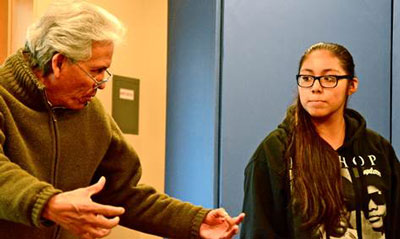 Cesar Castro and Quetzal Flores (Son Jarocho and Fandango); Agustin Lira and Patricia Wells (Chicano theater and music); Michael McCarthy (Storytelling); and Omar Ramirez (Drawing).
Cesar Castro and Quetzal Flores (Son Jarocho and Fandango); Agustin Lira and Patricia Wells (Chicano theater and music); Michael McCarthy (Storytelling); and Omar Ramirez (Drawing).
“Through ACTA’s work in diverse communities, it is apparent that traditional arts and practices do not solely exist for the purpose of entertainment, but also reveal a grounding element of well-being and healthy community building for many individuals and organizations,” expressed Amy Kitchener, ACTA’s Executive Director. “ACTA’s residencies in traditional art forms will inherently encourage communal well-being and a sense of belonging, offering participants necessary opportunities for healing, transformation, and new skills.”
This Arts-in-Corrections pilot program is made possible by the California Department of Corrections and Rehabilitation (CDCR), which committed $1 million to add structured, contracted Arts-in-Corrections programs in selected state prisons. CDCR is also committed to a second year of support, providing $1.5 million for fiscal year 2014-15. The funds are administered by the California Arts Council. Both CDCR and the California Arts Council have a long history of providing arts programs in correctional facilities.
“Arts engagement is a valuable rehabilitation method that can provide positive change for inmates and for communities across our state,” said Wylie Aitken, Chair of the California Arts Council. “The Arts Council is pleased to award a contract to the Alliance for California Traditional Arts (ACTA), an exceptional organization, in partnership with the Department of Corrections and Rehabilitation. The arts are a powerful tool that can address many of the challenges facing the state of California.”
“Structured arts programs have proven results,” said CDCR Secretary Jeff Beard. “Not only are inmates channeling their energy into constructive, creative projects, they are also learning new skills and expressing themselves in positive ways.”
For further information, about the Arts-in-Corrections Pilot Project, visit the CAC’s website.
